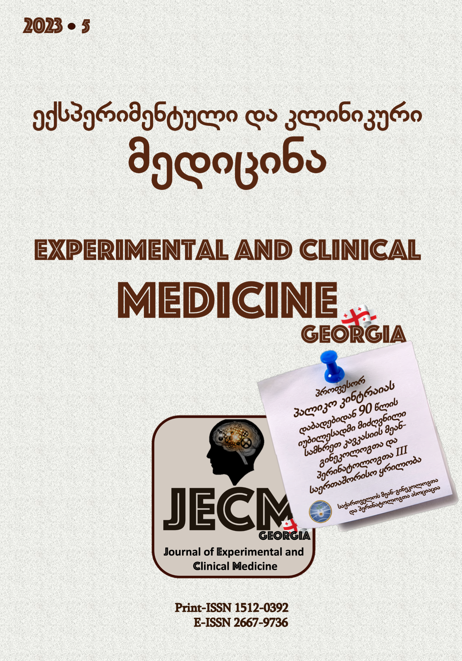FETAL HYPOXIA AND UTERINE BLOOD FLOW IN PATIENTS WITH FETAL GROWTH RETARDATION
DOI:
https://doi.org/10.52340/jecm.2023.05.19Keywords:
Fetal growth restriction, blood gases, hypoxia, ultrasound dopplerAbstract
Purpose: to assess fetal hypoxia and blood flow in the umbilical and middle cerebral arteries in fetal growth retardation (FGR). 97 pregnant women were examined, of which 77 had pregnancy complicated by FGR (main group), 20 women had pregnancy without complications (control group). The gestation period is 37-38 weeks. Measured blood gases (CO2 and pCO2), pH in the umbilical artery and vein. The systolic/diastolic ratio (S/D) was determined in the umbilical artery and middle cerebral artery (MCA); pulsation index (PI), resistance index (RI) and cerebroplacental ratio (CPR). FGR type 1 was diagnosed in 57.1% of cases, FGR type 2 in 42.9% of cases. The pH value in the umbilical artery and venous blood in the main group was on average significantly lower than in the control group (p<0.001, respectively). The average pO2 level was reduced in the main group in the umbilical artery (p=0.009) and in the venous blood (p=0.002). The average value of pCO2 in cord blood of the main group was significantly increased in arterial blood (p=0.035) and venous blood (p<0.001). The average values of S/D, PI and RI of the umbilical artery were significantly higher in the main group compared to the control (p<0.05). In MCA, the S/D indicator was lower (p=0.045). The CPR value in the main group was 28.7% lower than in the control group (p=0.086). In the main group, CPR correlated with all blood gases with an average, statistically significant relationship, and an average inverse relationship was noted with pCO2 (r=-0.577, p=0.054). Doppler indices (PI, RI) of the umbilical and middle cerebral arteries, as well as the cerebro-placental ratio, should be measured during prenatal monitoring of pregnancies with IGR, and should be an integral part of the assessment of a fetus with growth retardation.
Downloads
References
Barbieri M, Zamagni G, Fantasia I, Monasta L, Lo Bello L, Quadrifoglio M, et al. Umbilical Vein Blood Flow in Uncomplicated Pregnancies: Systematic Review of Available Reference Charts and Comparison with a New Cohort. Journal of Clinical Medicine. 2023;12(9):3132. doi: 10.3390/jcm12093132.
Cetin I, Taricco E, Mandò C, Radaelli T, Boito S, Nuzzo AM, et al. Fetal Oxygen and Glucose Consumption in Human Pregnancy Complicated by Fetal Growth Restriction. Hypertension. 2020;75:748–754. doi: 10.1161/HYPERTENSIONAHA.119.13727.
Ciobanu A, Wright A, Syngelaki A, Wright D, Akolekar R, Nicolaides KH. Fetal Medicine Foundation reference ranges for umbilical artery and middle cerebral artery pulsatility index and cerebroplacental ratio. Ultrasound Obstet Gynecol. 2019;53(4):465-472. doi: 10.1002/uog.20157.
D'Agostin M, Di Sipio Morgia C, Vento G, Nobile S. Long-term implications of fetal growth restriction. World J Clin Cases. 2023;11(13):2855-2863. doi: 10.12998/wjcc.v11.i13.2855.
Ganju S, Dhiman B, Sood N. Correlation of abnormal umbilical artery Doppler Indices and mode of delivery in intrauterine growth restriction. Trop J Obstet Gynaecol. 2019;36:403-7. doi: 10.4103/TJOG.TJOG_79_19.
Gumina DL, Su EJ. Mechanistic insights into the development of severe fetal growth restriction. Clinical Science. 2023;137(8), 679-695. doi: 10.1042/CS20220284.
Jamal A, Marsoosi V, Sarvestani F, Hashemi N. The correlation between the cerebroplacental ratio and fetal arterial blood gas in appropriate-for-gestational-age fetuses: A cross-sectional study. Int J Reprod Biomed. 2021;19(9):821-826. doi: 10.18502/ijrm.v19i9.9714.
Kaur T, Bhatt RK. The predictive role of color doppler sonography in evaluating hypoxia and acidosis in intrauterine growth restriction fetuses: correlation with arterial blood gas analysis. Int J Reprod Contracept Obstet Gynecol. 2020;9:1119-23. doi: 10.18203/2320-1770.ijrcog20200886.
Lane SL, Doyle AS, Bales ES, Lorca RA, Julian CG, Moore LG. Increased uterine artery blood flow in hypoxic murine pregnancy is not sufficient to prevent fetal growth restriction. Biology of Reproduction. 2020;102(3):660–670. doi: 10.1093/biolre/ioz208.
Malhotra A, Allison BJ, Castillo-Melendez M, Jenkin G, Polglase GR, Miller SL. Neonatal Morbidities of Fetal Growth Restriction: Pathophysiology and Impact. Front. Endocrinol. 2019;10:55. doi: 10.3389/fendo.2019.00055
McCowan LM, Figueras F, Anderson NH. Evidence-based national guidelines for the management of suspected fetal growth restriction: comparison, consensus, and controversy. Am J Obstetr Gynecol. 2018;218:S855–68. doi: 10.1016/j.ajog.2017.12.004.
Melamed N, Baschat A, Yinon Y, Athanasiadis A, Mecacci F, Figueras F, et al. FIGO (International Federation of Gynecology and Obstetrics) initiative on fetal growth: Best practice advice for screening, diagnosis, and management of fetal growth restriction. Int/ Journal of Gynecology & Obstetrics. 2021;152(S1):3-57. doi: 10.1002/ijgo.13522.
Moore LG, Wesolowski SR, Lorca RA, Murray AJ, Julian CG. Why is human uterine artery blood flow during pregnancy so high? American Journal of Phsiology Regulatory, Integrative and Comparative Physiology. 2022; 323(5): R694-R699. doi: 10.1152/ajpregu.00167.202.
Sirinoglu HA, Atakır K, Özdemir S, Konal M, Mihmanlı V. Middle cerebral artery to uterine artery pulsatility index ratios in pregnancy with fetal growth restriction regarding negative perinatal outcomes. J Surg Med. 2022;6(9):788-791. doi: 10.28982/josam.7319.
Sutovska H, Babarikova K, Zeman M, Molcan L. Prenatal Hypoxia Affects Foetal Cardiovascular Regulatory Mechanisms in a Sex- and Circadian-Dependent Manner: A Review. International Journal of Molecular Sciences. 2022;23(5):2885. doi: 10.3390/ijms23052885.
Zegarra RR, Dall’Asta A, Ghi T. Mechanisms of Fetal Adaptation to Chronic Hypoxia following Placental Insufficiency: A Review. Fetal Diagn Ther. 2022;49(5-6): 279–292. doi: 1159/000525717.
Zohav E, Zohav E, Rabinovich M, Alasbah A, Shenhav S, Sofer H, et al. Third-trimester Reference Ranges for Cerebroplacental Ratio and Pulsatility Index for Middle Cerebral Artery and Umbilical Artery in Normal-growth Singleton Fetuses in the Israeli Population. Rambam Maimonides Med J. 2019;10(4):e0025. doi: 10.5041/RMMJ.10379.






